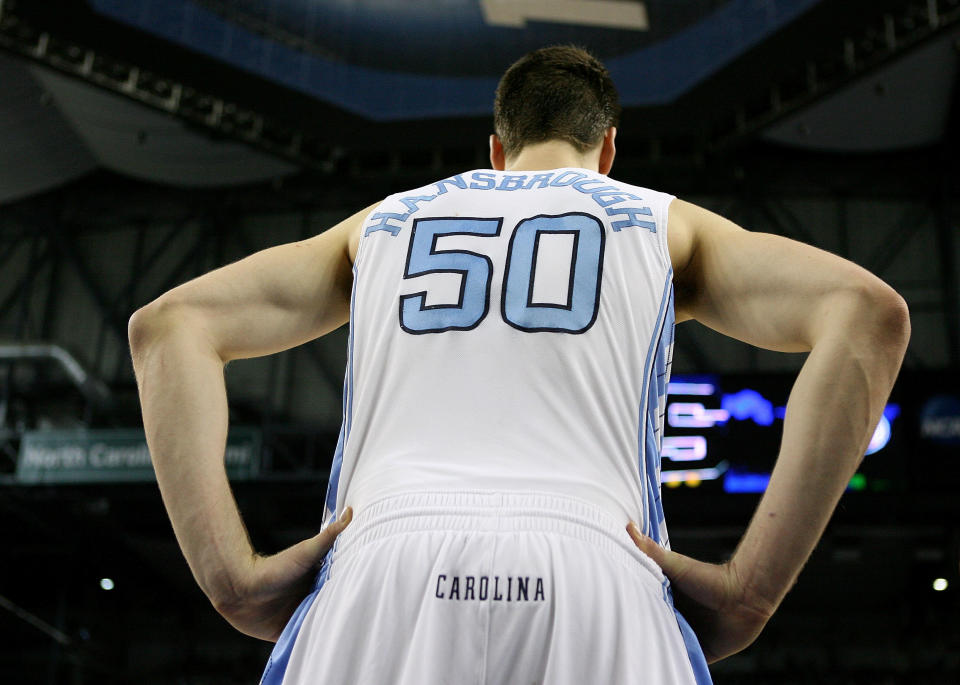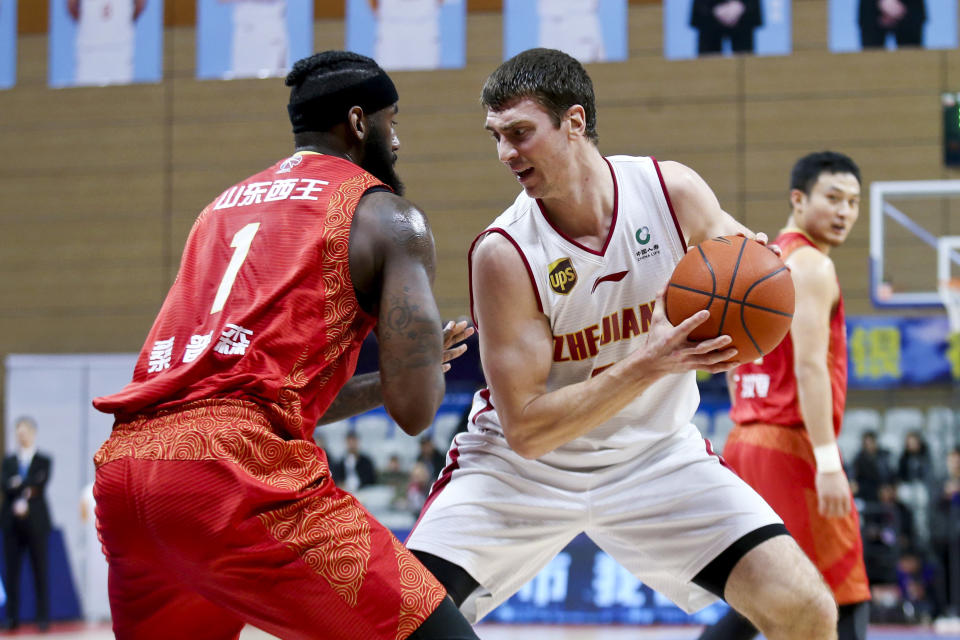How Tyler Hansbrough went from NCAA legend to playing in China

The most accomplished college basketball player of his generation has a theory for why his NBA career fizzled out more quickly than he expected.
Tyler Hansbrough considers himself a casualty of the NBA’s recent pace-and-space revolution, a throwback power forward stranded in an era when the league prefers mobile, athletic big men capable of shooting threes and defending away from the basket.
“I do think if the league isn’t as 3-point-driven and small-ball-driven, I’d probably still be playing right now,” the 33-year-old Hansbrough said. “I still think I can play very competitive basketball, but the NBA has changed in a way that doesn’t fit my game.”
When Hansbrough entered the NBA in 2009, Mike D’Antoni’s seven-seconds-or-less offense was still considered a curiosity, not a forerunner to a revolution. The NBA’s fastest-paced team during the 2008-09 season would be its slowest this season. The team that led the league in 3-pointers per game attempted that same year would rank 27th today.
By the time Golden State won the first of its three titles in 2015 with 6-foot-7 Draymond Green spending time at center, NBA coaches were viewed as dinosaurs if they didn’t go small and emphasize floor spacing and defensive versatility. There was no longer room in the league for a brutish big man like the 6-foot-9, 250-pound Hansbrough who couldn’t protect the rim well enough to play center yet lacked the perimeter skill or lateral quickness to be a modern-day power forward.
Unable to land a contract offer from an NBA team for the 2016-17 season, Hansbrough sat out for four months, then averaged 17.6 points and 12.2 rebounds in 13 games with the G-League’s Fort Wayne Mad Ants. That didn’t garner Hansbrough any NBA nibbles either, so the former North Carolina star has spent the past two seasons playing in China.
“I kind of saw it coming,” Hansbrough said. “Teams started going small and then when Golden State went small and started winning, it seemed like the whole league went in that direction. I tried to improve my 3-point shooting and shoot more, but that’s not really my game. I’ve always been a physical player. I can grow and get better in those things, but my bread and butter is always going to be rebounding and work around the basket.”
That Hansbrough didn’t make a greater impact in the NBA should have no impact on the legacy he built at North Carolina. Few players in the history of the storied Tar Heels program have achieved more in Carolina blue than Hansbrough.
Pressed into a starting role as a freshman after Marvin Williams and Sean May both entered the NBA draft, Hansbrough took advantage by averaging 18.9 points and 7.8 rebounds and earning second-team All-American honors. Hansbrough matched or improved on those numbers each of the next three seasons, winning national player of the year in 2008 and first-team All-American honors as a sophomore, junior and senior.
When eventual national champ Kansas throttled North Carolina in the 2008 national semifinals, Hansbrough chose to return to Chapel Hill for his senior season and made it his mission to capture a championship. A Tar Heels team led by Hansbrough, Ty Lawson, Danny Green and Wayne Ellington laid waste to the rest of the 2009 NCAA tournament field, winning all six games it played by double figures en route to Roy Williams’ second national title.
“There was a lot of pressure on us from the outside that year, but we also put a lot of pressure on ourselves,” Hansbrough said. “We felt we were the most talented team by far and we’d been to a Final Four. In our eyes, if we didn’t win the championship, the season would have been a failure to be honest.”
Capturing a national title may have been Hansbrough’s proudest achievement at North Carolina, but it’s not the one he’s asked about most often.
There’s his powerful two-handed dunk on UNC Asheville’s 7-foot-7 center Kenny George.
“I was a little frustrated, so I took it right at him,” Hansbrough said. “The crowd loved it.”
There’s his 4-0 career record at Duke.
“The celebrations when we’d come back to campus,” Hansbrough said, “that’s where we had the real fun.”
And there’s the flagrant foul delivered by Duke’s Gerald Henderson that broke Hansbrough’s nose but not his spirit.
“I would say we’re friends now,” Hansbrough said. “We don’t talk all the time, but we’re cool.”
Hansbrough’s historic career at North Carolina led Indiana to select him 13th overall in the 2009 NBA draft. Scouts viewed him as a low-risk, low-upside selection, one who lacked the potential of big men with superior size, athleticism or lateral quickness yet had a chance to help right away because of his low-post scoring, rebounding and relentless motor.
Hansbrough carved out a role as a high-energy rotation big man during four seasons with the Pacers, but already there were ominous signs that his style of play didn’t mesh with the direction the league was headed. While Hansbrough contributed by rolling hard to the rim for dunks, diving on loose balls or outmuscling big men for tip-ins, he did not sink a single 3-pointer as a Pacer and he was inefficient shooting more than a few feet from the rim.
Rather than back up David West for another season in Indiana, Hansbrough signed with Toronto as a free agent in 2013 with visions of proving he could provide more than just a jolt of energy off the bench. It’s a decision he now second guesses in hindsight as his playing time diminished with the Raptors and they seldom utilized him as more than a screener and rebounder when he was on the floor.
Since the 6-9, modestly athletic Hansbrough lacked the physical tools to alter shots at the rim in the NBA, Toronto was vulnerable defensively if he was the lone big man on the floor. At the same time, it became harder to space the floor and open up driving lanes for Kyle Lowry and DeMar DeRozan if the non-shooting Hansbrough and 7-foot Jonas Valanciunas played next to one another in the frontcourt.

“I had some good moments and good games in Toronto, but looking back I wish I could have done more to help the team,” Hansbrough said. “They had made some trades and they started going small. It probably just wasn’t a good fit.”
Never again would Hansbrough be a consistent part of an NBA rotation after leaving Toronto. In what turned out to be his final NBA season the next year in Charlotte, he appeared in only 44 games and averaged just 7.8 minutes.
While Hansbrough showed promise in his second season in Indiana and produced sporadic highlights thereafter, the hard-nosed, elbow-throwing forward’s NBA legacy is largely his ability to get under the skin of opponents.
There was the time he charged at Festus Ezeli after the Golden State center pushed him in the throat. Or the time Pistons guard Will Bynum received a one-game suspension for punching him in the stomach. Or the time he and Bulls forward Mike Dunleavy Jr. got tangled up vying for a rebound, leading to Hansbrough essentially tackling his opponent to the floor.
Ironically, the scrap Hansbrough still hears about most often is one he didn’t actually get into.
Fouled from behind during a 2013 preseason game, Hansbrough angrily turned around only to bump chests with a snarling Ron Artest. Hansbrough backed off hilariously quickly, telling the sometimes quick-tempered Artest, “My bad, my bad.”
“I wasn’t really in the mood to mess with Ron Artest at the time,” Hansbrough said with a laugh. “A lot of people joke with me about that, and I always say, ‘I’m pretty sure you would have kicked his ass if you were in my situation.’ ”
Six years later, Hansbrough and Artest can both chuckle at their viral moment.
“I like running into Ron to be honest,” Hansbrough said. “He handled it well and he reached out afterward. He’s a great dude.”
There have been fewer viral moments for Hansbrough the past couple years as he has been out of the NBA spotlight. He chose to play in China because the money is comparable to other top overseas leagues, the competition is strong and the season is shorter, meaning an NBA team beset by frontcourt injuries would be able to sign him in February or March.
In 27 games with Zhejiang this past season, Hansbrough got to show aspects of his game that he never could as a role player in the NBA. He averaged 20.1 points and 10.2 boards before a late-season calf injury forced him to return to the U.S.
Hansbrough said he enjoyed the experience of playing in China, from the basketball-crazed fans, to the delicious noodles and dumplings, to big cities with more to offer than he expected. He intends to play again next season, whether in China or another top overseas league.
“I want to play as long as I’m healthy and can compete at a high level,” Hansbrough said. “I would have liked to have played in the NBA longer, but there were some good moments, I had some great times and I’m glad I got the experience. Not everyone gets to play seven years in the NBA.”
More from Yahoo Sports:



